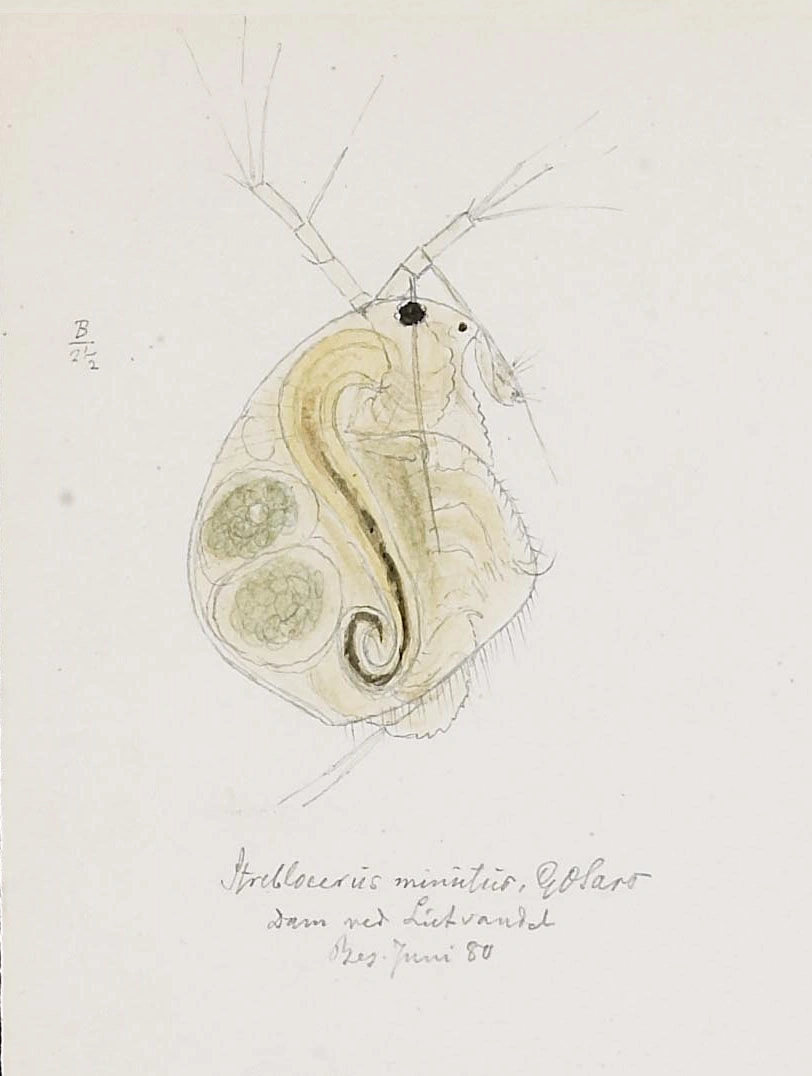Streblocerus serricaudatus
Streblocerus serricaudatus is the smallest species that belongs to the family Macrothricidae. Its postabdomen is short and broad and has a distinct incurvature somewhat behind the middle. Though it is most common when pH<4.5, it seems quite tolerant to varying pH.
Key characteristics
Streblocerus serricaudatus (female)
Seen from the lateral side the dorsal edge of Streblocerus serricaudatus forms an uneven curve that is much more curved anterior to the eye than dorsal to it. The oscellus is placed at the tip of the rostrum. The first pair of antennae is relatively robust and has a strong spine attached anteriorly close to the base. The four-segmented second antennae is considerably longer and thinner than the three-segmented antennae in Macrothrix spp. The postabdomen is short and broad. Somewhat behind the middle, its posterior edge has a distinct incurvature, and distal to this it is armed with six strong teeth on each side. It has a whitish grey colour with a tinge of green.
Female: Length 0.4–0.6 mm
Male: Length 0.3 mm
Ecology and distribution
S. serricaudatus is a common littoral species found in almost 15 % of the investigated localities. It is more commonly found in small ponds than in large lakes and it is rare in the alpine zone. It is found within the range of pH 3.8–8.0 being especially common in the most acidic localities (<4.5). The majority of records are from waterbodies with conductivity between 1.5 and 7.0 mS/m.
| Vitenskapelig navn | < 4,5 | 4,5 - 4,9 | 5,0 - 5,4 | 5,5 - 5,9 | 6,0 - 6,4 | 6,5 - 7,0 | 7,0 - 7,4 | > 7,5 |
|---|---|---|---|---|---|---|---|---|
| 55 | 15,5 | 18 | 26,8 | 14,2 | 12 | 10,6 | 10,3 |
| Vitenskapelig navn | < 1,0 | 1,0 - 1,4 | 1,5 - 1,9 | 2,0 - 2,9 | 3,0 - 3,9 | 4,0 - 4,9 | 5,0 - 6,9 | 7,0 - 9,9 | > 10,0 |
|---|---|---|---|---|---|---|---|---|---|
| 6,5 | 7,9 | 15,6 | 22,1 | 30,3 | 24,7 | 14,1 | 13,9 | 7,9 |
| Vitenskapelig navn | < 0,01 | 0,01 - 0,09 | 0,1 - 0,9 | 1,0 - 9,9 | 10,0 - 99 | 100 - 999 | > 1000 |
|---|---|---|---|---|---|---|---|
| 21,6 | 18,4 | 18,1 | 19,1 | 12,2 | 8,2 | 4,3 |
| Vitenskapelig navn | < 100 | 100-299 | 300-499 | 500-699 | 700-999 | >1000 |
|---|---|---|---|---|---|---|
| 16,8 | 17,5 | 15,8 | 22,9 | 7,3 | 2,1 |
